5 Mid Cap Funds Down by Over 15% in the Recent Market Correction
Divya Grover
Feb 24, 2025 / Reading Time: 6 min
Listen to 5 Mid Cap Funds Down by Over 15% in the Recent Market Correction
00:00
00:00
The Indian equity market has witnessed a significant downturn since the end of September 2024 onwards. Mid-cap and small-cap stocks were at the forefront of the selloff, resulting in severe losses for investors in the once-favoured segment of the market.
As the mid-cap stocks suffered amid earnings downgrades, stretched valuations, and global trade tensions, investors in Mid Cap Funds too have witnessed a sharp decline in their NAVs.
Amid the ongoing market correction, around 10 out of 29 schemes in the Mid Cap Fund plunged lower than their respective benchmark indices.
How Mid Cap Funds fared in the recent market correction
| Category |
5 Months Returns (%) |
| Top Performing Scheme |
-11.13 |
| Bottom Performing Scheme |
-17.81 |
| Category Average |
-15.17 |
| Nifty Midcap 150 - TRI |
-14.98 |
| BSE 150 MidCap - TRI |
-16.45 |
Data as of February 20, 2025
Past performance is not an indicator for future returns
Returns are absolute and in percentage
Direct Plan - Growth option considered
(Source: ACE MF, data collated by PersonalFN Research)
Although short-term performance is not a reliable indicator of the fund's future potential, it makes sense to review the portfolio during extreme market conditions. Only those schemes that do well across most market phases can be expected to generate meaningful alpha over the long run.
Here are the 5 Mid Cap Funds that are down by over 15% in the recent market correction:
#1 HSBC Midcap Fund
Launched in August 2004, HSBC Midcap Fund was merged with L&T Midcap Fund and the surviving scheme was renamed. The fund currently has an AUM of Rs 10,753 crore.
The fund uses a mix of the 'top-down' and 'bottom-up' approach and actively looks to identify opportunities arising out of macroeconomic dynamics, new reforms and policies, etc. It invests around 65% of its assets in mid caps, 15-20% in large caps, and 10-20% in small caps.
Its top holdings include CG Power and Industrial Solutions, Persistent Systems, PB Fintech, BSE, Dixon Technologies (India).
In the last 5 months, HSBC Midcap Fund's NAV has witnessed a decline of 17.8% higher than the decline of 15% in its benchmark Nifty Midcap 150 - TRI index.
For more information check out HSBC Midcap Fund's factsheet.
HSBC Midcap Fund's performance in the last 5 months
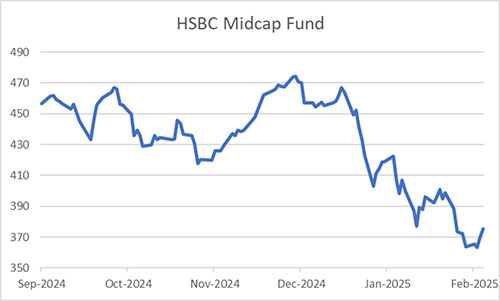 Past performance is not an indicator for future returns
Past performance is not an indicator for future returns
Data as of February 20, 2025
Direct Plan - Growth option considered
(Source: ACE MF, data collated by PersonalFN Research)
#2 UTI Mid Cap Fund
Launched in July 2005, UTI Mid Cap Fund aims to blend the value and growth style of investing to identify companies with scalable business models and healthy long-term growth prospects. It currently has an AUM of Rs 11,125 crore.
The Fund aims to maintain a well-diversified portfolio and follows a patient approach towards companies in the portfolio. It invests around 65% of its assets in mid caps, about 10% in large caps, and 20-25% in small caps.
Its top holdings include Coforge, Persistent Systems, Phoenix Mills, PB Fintech, and Solar Industries India.
In the last 5 months, UTI Mid Cap Fund's NAV has witnessed a decline of 17.6% compared to a decline of 15% in its benchmark Nifty Midcap 150 - TRI index.
For more information check out UTI Mid Cap Fund's factsheet.
UTI Mid Cap Fund's performance in the last 5 months
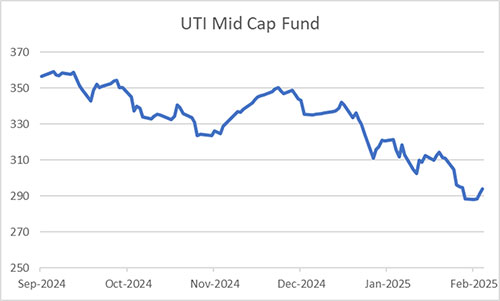 Past performance is not an indicator for future returns
Past performance is not an indicator for future returns
Data as of February 20, 2025
Direct Plan - Growth option considered
(Source: ACE MF, data collated by PersonalFN Research)
#3 Bandhan Midcap Fund
Launched in August 2022, Bandhan Midcap Fund is one of the youngest schemes in the Mid Cap Fund category. It currently has a small-sized AUM of Rs 1,491 crore.
The fund's emphasis is on identifying high-quality companies with better growth prospects, sound corporate management, and favourable risk-reward from a medium to long-term perspective. It invests around 65% of its assets in mid caps, around 15% in large caps, and 15-20% in small caps.
Its top holdings include Trent, Persistent Systems, The Indian Hotels Company, Dixon Technologies (India), and Prestige Estates Projects.
In the last 5 months, Bandhan Midcap Fund's NAV has witnessed a decline of 17.5%, higher than the decline of 16.5% in its benchmark BSE 150 MidCap - TRI index.
For more information check out Bandhan Midcap Fund's factsheet.
Bandhan Midcap Fund's performance in the last 5 months
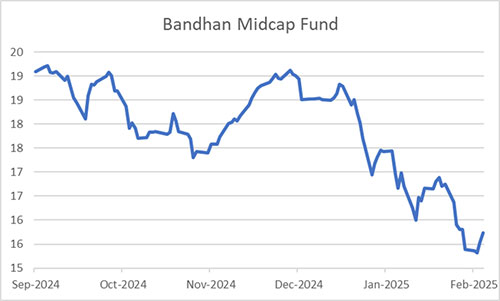 Past performance is not an indicator for future returns
Past performance is not an indicator for future returns
Data as of February 20, 2025
Direct Plan - Growth option considered
(Source: ACE MF, data collated by PersonalFN Research)
#4 Quant Mid Cap Fund
Originally launched in February 2001, Quant Mid Cap Funds was earlier categorised as a hybrid fund but was recategorised and renamed in 2018. It currently has an AUM of Rs 8,608 crore.
The fund frequently adjusts its portfolio and is constantly on the hunt for attractive opportunities across sectors. It allocates around 65-75% of its assets in mid caps, 15-25% in large caps, with nominal exposure in small caps.
Its top holdings include Reliance Industries, IRB Infrastructure Developers, Aurobindo Pharma, Container Corporation of India, and Marico.
In the last 5 months, Quant Mid Cap Fund's NAV has witnessed a decline of 17.4%, higher than the decline of 15% in its benchmark Nifty Midcap 150 - TRI index.
For more information check out Quant Mid Cap Fund's factsheet.
Quant Mid Cap Fund's performance in the last 5 months
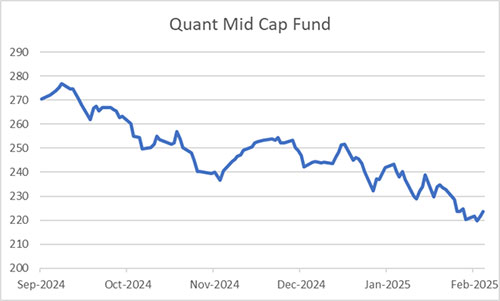 Past performance is not an indicator for future returns
Past performance is not an indicator for future returns
Data as of February 20, 2025
Direct Plan - Growth option considered
(Source: ACE MF, data collated by PersonalFN Research)
#5 Aditya Birla SL Midcap Fund
Launched in October 2002, Aditya Birla SL Midcap Fund aims to invest in companies that have high growth potential and can be large caps of tomorrow. It currently has an AUM of Rs 5,533 crore.
The fund focuses on long-term fundamentally driven values and aims to maintain a well-diversified portfolio at all times. It holds 65-70% of its assets in mid caps, 20-25% in small caps, and up to 10-15% in large caps.
Its top holdings include Fortis Healthcare, Torrent Power, Cholamandalam Financial Holdings, Glenmark Pharmaceuticals, and AU Small Finance Bank.
In the last 5 months, Aditya Birla SL Midcap Fund's NAV has witnessed a decline of 17.2%, higher than the decline of 15% in its benchmark Nifty Midcap 150 - TRI index.
For more information check out Aditya Birla SL Midcap Fund's factsheet.
Aditya Birla SL Midcap Fund's performance in the last 5 months
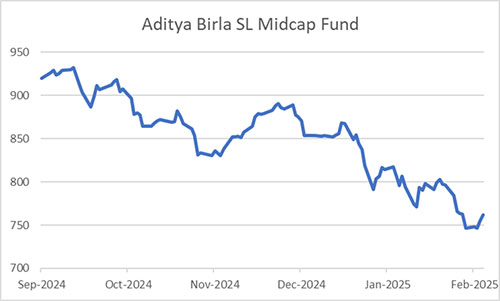 Past performance is not an indicator for future returns
Past performance is not an indicator for future returns
Data as of February 20, 2025
Direct Plan - Growth option considered
(Source: ACE MF, data collated by PersonalFN Research)
Conclusion
Despite the recent corrections, the valuations in the mid-cap segment are still above their historical averages. This means that mid-cap index may continue to witness further correction and high volatility unless corporate earnings show remarkable improvement and till global uncertainties show signs of receding.
[Read: Decoding the Recent Market Correction: What's Behind the Fall in Mid and Small Caps]
Mid-cap stocks tend to witness higher drawdowns during bearish and uncertain market conditions. Thus, Mid Cap Funds may witness sharp fluctuations in their NAVs in the near future compared to Large Cap Funds. However, they may fare better than Small Cap Funds which usually carry higher risk.
Although Mid Cap Funds have high return potential, one should avoid investing in them with a short-term view. It is preferable to have an investment horizon of at least 5-7 years when investing in Mid Cap Funds.
In view of the ongoing market corrections, one should take cognisance of one's investment objectives as well as the specific performance of the fund across both upside and downside market phases to determine whether one should stay the course or make any adjustments to the portfolio.
Watch this video to know about the best performing Mid Cap Funds based on 3-year rolling returns that are worth monitoring in 2025:
Note: Â This write up is for information purpose and does not constitute any kind of investment advice or a recommendation to Buy / Hold / Sell a fund. Returns mentioned herein are in no way a guarantee or promise of future returns. As an investor, you need to pick the right fund to meet your financial goals. If you are not sure about your risk appetite, do consult your investment consultant/advisor. Mutual Fund Investments are subject to market risks, read all scheme related documents carefully. Registration granted by SEBI, Membership of BASL and certification from NISM no way guarantee performance of the intermediary or provide any assurance of returns to investors.
The securities quoted are for illustration only and are not recommendatory.
We are on Telegram! Join thousands of like-minded investors and our editors right now.
DIVYA GROVER is the co-editor for FundSelect, the flagship research service of PersonalFN. She is also the co-editor of DebtSelect. Divya is an avid reader which helps her in analysing industry trends and producing insightful articles for PersonalFN’s popular newsletter – Daily Wealth letter, read by over 1.5 lakh subscribers.
Divya joined PersonalFN in 2019 and has since then used stringent quantitative and qualitative parameters to analyse funds to provide honest and unbiased research to investors. She endeavours to enable investors to make an informed investment decision and thereby safeguard their wealth.
Disclaimer: Investment in securities market are subject to market risks, read all the related documents carefully before investing.
This article is for information purposes only and is not meant to influence your investment decisions. It should not be treated as a mutual fund recommendation or advice to make an investment decision in the above-mentioned schemes.